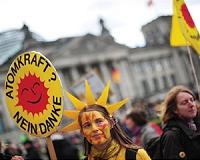 |
Moscow (UPI) Mar 25, 2011 Russia is interested in utilizing spent nuclear fuel dry storage technology developed by the United States. Head of the Russian Federation's Rosatom Nuclear Energy State Agency Sergei Kiriyenko met with U.S. nuclear industry representatives Wednesday at the Russian Embassy in Washington. He said: "Among the technologies that are well-developed in the U.S., I think in the nearest future we will be interested in the SNF dry storage in containers. I think, following the tests that we are carrying out today under existing projects, one of the conclusions will be to replace SNF wet storage facilities by dry ones." Kiriyenko added that Rosatom was cooperating with U.S. companies in using such containers, including "by way of setting up a joint venture," Interfax-Agentstvo Veonnykh Novostei news agency reported Friday. Rosatom controls the Russian Federation's nuclear power conglomerate Atomenergoprom. Unlike in the United States where there is a clear delineation between civilian nuclear power companies, in Russia Rosatom is also responsible for nuclear weapons companies, research institutes, governmental nuclear and radiation safety agencies and also represents Russia worldwide in the field of civilian use of nuclear energy and international nonproliferation efforts. Many of the Russian Federation's nuclear power reactors are of the RBMK 1000 design, similar to the one that had a disastrous fire in April 1986 at Chernobyl in Ukraine. In the aftermath of the accident, rather than shutter the facilities, while some of the RBMK reactors were to be shut down, they instead had their operational periods extended after additional safety systems were integrated into their designs. In the aftermath of the accident at the Japanese nuclear plant Fukushima-1, Rosatom and the Federal Service for Ecological, Technological and Nuclear Supervision or Rostekhnadzor, have begun security checks at Russia's 10 nuclear power plants housing 31 reactor units, along with 109 research reactors. Russia currently meets 16 percent of its electrical needs using nuclear power. Russian civilian nuclear energy technology is also a valuable export concern. Russian President Dmitry Medvedev recently confirmed plans for Rosatom building Turkey's first nuclear power plant at Akkuyu near Mersin on the Mediterranean coast. An agreement concerned that plant was signed in May 2010 but the project has been an object of contention for years for Turkish environmentalists because of the site's proximity to a seismic fault. The European Community has criticized Russia's decision to grant energy-poor Belarus a credit of more than $9 billion to build a nuclear power plant near Ostrovets, 35 miles from Vilnius, alarming Lithuania, which closed its own RBMK-1500 nuclear power station at Ignalina in December 2004. Besides Belarus, Rosatom is building or planning nuclear power plants in 13 countries, including India, Bulgaria, and Iran, while Russia has 24 new nuclear power stations planned.
Share This Article With Planet Earth
Related Links Nuclear Power News - Nuclear Science, Nuclear Technology Powering The World in the 21st Century at Energy-Daily.com
 More than 200,000 Germans march against nuclear power
More than 200,000 Germans march against nuclear powerBerlin (AFP) March 26, 2011 An estimated 200,000 people took to the streets around Germany Saturday to protest against nuclear power, upping the pressure on Chancellor Angela Merkel on the eve of a critical state election. One of the organisers Ausgestrahlt said 250,000 people took part in demonstrations in four major cities marching under the banner "Fukushima Means: No More Nuclear Power Stations.". Marches took ... read more |
|
| The content herein, unless otherwise known to be public domain, are Copyright 1995-2010 - SpaceDaily. AFP and UPI Wire Stories are copyright Agence France-Presse and United Press International. ESA Portal Reports are copyright European Space Agency. All NASA sourced material is public domain. Additional copyrights may apply in whole or part to other bona fide parties. Advertising does not imply endorsement,agreement or approval of any opinions, statements or information provided by SpaceDaily on any Web page published or hosted by SpaceDaily. Privacy Statement |